 |
 |
Water can be decomposed by passing an electric current through it. When this happens, the electrons from the electric current cause an oxidation-reduction reaction. At one electrode, called the cathode, electrons pass into the solution and cause a reduction. At the other electrode, called the anode, electrons leave the solution completing the circuit, and cause an oxidation.
In order to carry out electrolysis the solution must conduct electric current. Pure water is a very poor conductor. To make the water conduct better we can add an electrolyte to the water. This introduces another problem though. Many electrolytes that we add electrolyze more easily than water. Sulfate ions do not electrolyse as easily as water, so sulfates are often used to enhance the conductivity of the water. At one of the electrodes, electrons (from a current source like a battery) are added to the water molecules (since electrons are added, this is the negative terminal of the battery). The following reduction takes place at the cathode, producing hydrogen gas.
2H2O + 2e- |
Reduction = Cathode |
At the other electrode, electrons are removed from the water (so it is the positive end of the battery) and enter the electrode. This completes the circuit so current can flow. At this electrode, called the anode, water is oxidized:
| H2O |
Oxidation = Anode |
Since an oxidation cannot occur without a reduction, these two reactions must occur at the same time. If we add them together, and cancel out the similar terms, we will get the net overall reaction.
| 2H2O | + 2e- | H2(g) | + 2OH- | ||
| H2O | 1/2O2 (g) | + 2H+ | + 2e- | ||
| + |
H2 + 1/2O2 (g) | + |
+ |
||
which is the same as
H2O ![]() H2 + 1/2O2 (g)
H2 + 1/2O2 (g)
1. Prepare your electrolysis apparatus if it is not already set up for you. Sharpen both ends of the pencil. Attach the battery clip wires to the sharpened pencil lead. If you do not use the alligator clips, strip about 2 cm of the end of the wire, and wrap it about the pencil lead. Tape or hot glue this wire in place.
2. Make a solution that is saturated with sodium sulfate in de-ionized water. You will need about 100 mL. Alternatively, you may use a solution of magnesium sulfate.
3. Add a few drops of acid-base indicator to the solution you prepared above. Your solution should be lightly colored. Choose any of the indicators that are convenient, though universal indicator, bromcresol green, or red cabbage indicator will give the most obvious change at both electrodes. Pour this solution into your petri dish
4. Put the free end of the pencil leads into the petri dish, submerged under the water, and about 2 cm apart.
5. Attach the battery, and observe any changes for several minutes. Note which end is positive (the red wire) and negative (the black wire), and what results you observe.
It is almost impossible to collect the gases produced in this experiment. While it appears that a lot of bubbles form, in fact there is really not a lot of gas being produced. It is possible to collect the gas in a different apparatus, which can use higher currents than the one described here. An example of this is shown in the video.
1. Electrons flow from the black wire (negative) into the solution. What do you observe for color change at the negative electrode? Compare this to an acid-base indicator color chart for the indicator you used. Explain in terms of the half-reaction occurring there
2. Electrons flow from the solution into the red wire (positive). What do you observe for color change at the positive electrode? Compare this to an acid-base indicator color chart for the indicator you used. Explain in terms of the half-reaction occurring there.
3.From the video, compare the volumes of the two gases collected. What conclusion can you reach?
It actually takes quite a large amount of current to produce much oxygen or hydrogen gas. For example, how much electrical current would be needed to produce one mole of oxygen gas? This is a mass of 32 g, and at room temperature and pressure conditions would occupy about 24 litres.
Step 1: From the balanced equation at the anode
| H2O |
Oxidation = Anode |
you can see that it takes 4 moles of electrons to produce 1 mole of oxygen gas.
Step 2: Electrical current is usually measured in amperes. A current of 1 amp for 1 second is one Coulomb (C) of electrons. There are approximately 95,500 C in a mole of electrons, so our 4 moles of electrons is
4 x 96,500 = 386,000 C
Step 3: Since the Coulomb is an ampere per second (1 C/s = 1 amp), we can't go any further unless we make some assumptions about how long it is going to take us to make this oxygen. Just for the sake of doing the calculation, lets assume it will take us one hour (3600 s). Then we will need:
| 386,000 C 3600 s |
= 107 amp |
That is a fairly large current (considering that the typical wall plug gives a maximum of 15 amps).